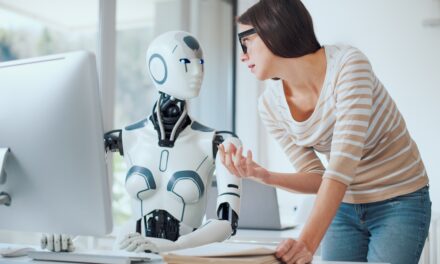My four-year-old and I were watching The Wizard of Oz last weekend.
The first part of this 1939 classic takes place in rural Kansas, and those early scenes are filmed in black and white.
But my daughter couldn’t understand why Dorothy and her family looked like that.
I had to explain that TV shows weren’t always in technicolor.
In fact, when I was her age, only about half of Americans had color TVs. We also had to make phone calls from a little device with numbered buttons that hung on the kitchen wall.
Now we can FaceTime her grandparents in 4K from the palm of our hands.
It’s a stark reminder that the Information Age happened slowly at first…
But now it feels like everything is changing all at once.
Thanks to artificial intelligence, we are about to see change accelerate like no other time in human history.
And I recently came across a fascinating new research paper that proves this point.
Like it or not, AI is here. And it’s going to become a bigger part of our lives in the years to come.
But this paper’s findings challenge some common assumptions about the relationship between human expertise and AI.
So, let’s dive in…
Automating the Ideation Process
The study was conducted by a team of economists. It centers around the impact of an AI tool designed to assist scientists in the materials science field.
This AI tool was created to automate a key part of their research workflow…
The generation of new candidate materials to test and develop.
You know… brainstorming. Trying to figure out what combination of materials had the best chance to become something worthwhile.
Traditionally, this “ideation” phase has been a highly creative, human-driven process, relying on the domain expertise and intuitions of trained researchers.
Generating new ideas is something we humans do well.
But the AI tool was able to take over a significant portion of this work.
It rapidly produced large volumes of novel material designs for scientists to evaluate.
And that led to a substantial increase in the overall rate of materials discovery and downstream innovation, as measured by patent filings and product development.
So far, so good, right? AI is supercharging scientific productivity.
But the story doesn’t end there.
The Central Role of Human Judgment
As the researchers dug deeper, they began to uncover a more nuanced dynamic at play.
While the AI was able to automate the ideation process, the scientists’ ability to effectively evaluate and prioritize the model’s suggestions was a critical factor in determining the AI tool’s impact.
Specifically, the team found that the boost in discovery rates wasn’t evenly distributed across all researchers.
In fact, there was a wide gap between those who were able to leverage the AI effectively, and those who struggled.
The key differentiator?
It came down to each scientists’ level of domain expertise and judgment.
The researchers who possessed deep knowledge of materials science and the ability to intuitively assess the quality and promise of the AI-generated candidates were able to quickly identify the most viable options.
They could then focus their experimental efforts on testing the highest-potential ideas.
That ramped up productivity.
On the other hand, scientists with weaker judgment skills found themselves overwhelmed by the sheer volume of AI-generated compounds.
They were unable to reliably distinguish the promising leads from the duds.
As a result, they ended up wasting significant time and resources testing low-quality suggestions.
And that dampened the benefits of using AI.
Redefining the Skillset for Success
This paper reveals a fundamental shift in the nature of scientific work in the age of AI.
Historically, the ability to generate novel ideas is the hallmark of a successful scientist.
But this study shows that when working with AI, the real value lies in the scientist’s ability to effectively evaluate and prioritize those ideas…
A skill that hinges more on deep domain knowledge and intuitive judgment than on pure creativity.
Researchers also found that this new dynamic led to a notable shift in how these scientists allocated their time.
There was a dramatic reduction in the hours spent on ideation tasks…
And there was a corresponding increase in the time spent on evaluating and testing the model’s output.
That tells us something about the future of work.
The Future of Work
It tells us that humans and AI aren’t in a zero-sum competition.
The AI in this study was able to drive significant gains in productivity…
But the tool was only truly effective when it was paired with skilled scientists who could leverage their deep domain knowledge to make sense of the model’s output.
In other words, AI alone isn’t the answer.
It’s not a silver bullet that will suddenly make humans redundant…
And you can’t just add AI to the workplace and expect magic to happen.
People using AI need to have the skills and experience to work effectively with it.
And since the dynamic of AI augmenting, rather than replacing, human expertise is likely to play out in workplaces across the world…
I predict that companies will start looking for different skills during the hiring process.
They’ll start prioritizing skills like intuitive pattern recognition, strategic thinking and the ability to ask the right questions.
Because the most successful workers of the future will be those who know how to work well with AI.
AI is here, like it or not. But don’t worry…
It still needs us.
Regards,

Ian King
Chief Strategist, Banyan Hill Publishing









